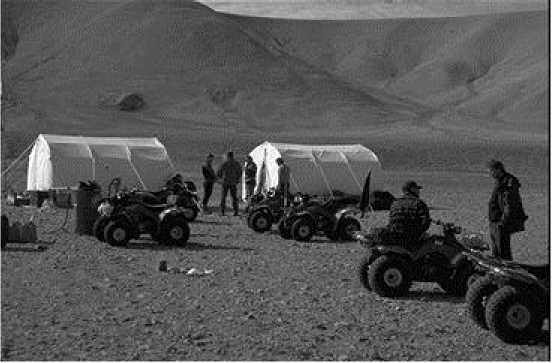WJ Clancey — Visualizing Practical Knowledge
down—when you re-present the material, rearranging it and juxtaposing different events,
further patterns will emerge.
Example observation and design implication
Figure 2 is a good example of ethnographic data and how it can be applied to designing
work systems. By considering how space is used and where conversations occur, I
discovered that, besides the obvious use of the kitchen table for long discussions
throughout the day, most conversations in camp occurred on and around the ATVs (all
terrain vehicles). There are several reasons for this pattern—the space is close to the work
and mess tents, where people tended to come and go throughout the day, and crucially,
the ATVs were parked in one place. The people who were at Haughton for the entire
expedition (about a month) generally took possession of an ATV and parked it by their
tent. But most people used whatever ATV was available and parked it in the middle of
the camp, near the fuel supply. Interestingly, these ATVs were not just left randomly, but
parked more or less in a line, along a power cord that stretched from the work tent (on the
left) to a generator on another terrace about 100 feet away.

Figure 2: Emergent spaces for conversation created by tacit understanding of how
to park ATVs
Where to park the ATVs was never discussed; the group constructed this emergent
structure implicitly, in their own individual behaviors. The pattern tended to replicate and
reinforce itself by a positive feedback mechanism—as a practice, people tended to return
More intriguing information
1. THE RISE OF RURAL-TO-RURAL LABOR MARKETS IN CHINA2. Stillbirth in a Tertiary Care Referral Hospital in North Bengal - A Review of Causes, Risk Factors and Prevention Strategies
3. The name is absent
4. Empirical Calibration of a Least-Cost Conservation Reserve Program
5. Retirement and the Poverty of the Elderly in Portugal
6. The open method of co-ordination: Some remarks regarding old-age security within an enlarged European Union
7. Announcement effects of convertible bond loans versus warrant-bond loans: An empirical analysis for the Dutch market
8. The name is absent
9. Langfristige Wachstumsaussichten der ukrainischen Wirtschaft : Potenziale und Barrieren
10. Comparative study of hatching rates of African catfish (Clarias gariepinus Burchell 1822) eggs on different substrates